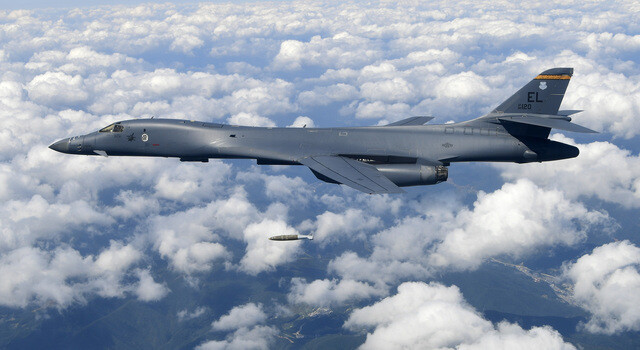hankyoreh
Links to other country sites 다른 나라 사이트 링크
US B-1B bombers again conduct military exercises over Korean Peninsula

Two US B-1B strategic bombers made sorties over the Korean Peninsula on the evening of Oct. 10 for air-to-surface missile exercises. The exercises came 17 days after a US Air Force B-1B squadron previously crossed the Northern Limit Line (NLL) to perform flight exercises outside North Korean airspace in the East Sea on the evening of Sept. 23 and early morning of Sept. 24. The US military also belatedly revealed on Oct. 11 that one of its nuclear-powered submarines had put in at Jinhae, South Gyeongsang Province.
The moves are being interpreted as shows of force aimed at forestalling potential provocations by North Korea. B-1B bombers – the so-called “swans of death” – conducted air-to-surface missile exercises in the absence of any North Korean test launches, nuclear tests, or other provocations risks raising military tensions on the peninsula.
“Yesterday evening, two South Korean Air Force F-15K fighters held joint exercises with two US Air Force B-1B strategic bombers that took off from Andersen Air Base on Guam,” the Joint Chiefs of Staff reported on Oct. 11.
The [South Korean] Joint Chiefs of Staff explained that the latest exercises were “part of regular deployment exercises aimed at enhancing extended deterrence capabilities” and said the South Korean and US Air Forces would “continue working to improve allied operational capabilities for a swift response in the event of an emergency.”
B-1B sorties over the Korean Peninsula have recently become a regular occurrence,
happening roughly once every two to three weeks. A military official explained that the frequency “shows how serious North Korean provocations are viewed.” A senior Blue House official called the latest B1-B flight “part of a rotational deployment of South Korea and US strategic assets as agreed upon during the latest South Korea-US summit.”
The B-1B squadron on Oct. 11 is reported to have remained within the South Korean Air Defense Identification Zone (KADIZ) for around three hours after arriving at 9 pm. The B1-B bombers traveled north over the East Sea from the Korea Strait before turning west off Gangneung, crossing the Korean Peninsula, and returning southward along the West Sea. The B-1Bs were escorted by South Korean Air Force F-15K aircraft and conducted simulated one set of air-to-surface missile firing exercises each over the East and West Seas.
“No missiles were launched at actual targets. This was training with firing procedures toward a selected hypothetical target,” a senior military official explained.
Japanese F-15 fighters previously accompanied the B-1Bs as they passed through the Japanese Air Defense Identification Zone (JADIZ). The US Pacific Command said it was the first time aircraft from the three sides had conducted joint training at night.
“Flying and training at night with our allies in a safe, effective manner is an important capability shared between the U.S., Japan, and the Republic of Korea,” it was quoted by the foreign press as saying.
The command posted an announcement on its official website the same day stating that the “Los Angeles-class attack submarine USS Tucson (SSN 770) arrived at U.S. Fleet Activities Chinhae [Jinhae], Oct. 7, for a visit as part of its deployment to the Indo-Asia-Pacific region.”
The Tucson reportedly left Jinhae on the afternoon of Oct. 11 for operations. Based in Pearl Harbor in Hawaii, the Tucson carries a crew of 150 , equipped with 12 vertical Tomahawk cruise missile launch systems and four torpedo launch systems.
By Park Byong-su, senior staff writer and Jung Yu-gyung, staff reporter
Please direct questions or comments to [english@hani.co.kr]

Editorial・opinion
![[Editorial] Penalties for airing allegations against Korea’s first lady endanger free press [Editorial] Penalties for airing allegations against Korea’s first lady endanger free press](https://flexible.img.hani.co.kr/flexible/normal/500/300/imgdb/original/2024/0502/1817146398095106.jpg) [Editorial] Penalties for airing allegations against Korea’s first lady endanger free press
[Editorial] Penalties for airing allegations against Korea’s first lady endanger free press![[Editorial] Yoon must halt procurement of SM-3 interceptor missiles [Editorial] Yoon must halt procurement of SM-3 interceptor missiles](https://flexible.img.hani.co.kr/flexible/normal/500/300/imgdb/child/2024/0501/17145495551605_1717145495195344.jpg) [Editorial] Yoon must halt procurement of SM-3 interceptor missiles
[Editorial] Yoon must halt procurement of SM-3 interceptor missiles- [Guest essay] Maybe Korea’s rapid population decline is an opportunity, not a crisis
- [Column] Can Yoon steer diplomacy with Russia, China back on track?
- [Column] Season 2 of special prosecutor probe may be coming to Korea soon
- [Column] Park Geun-hye déjà vu in Yoon Suk-yeol
- [Editorial] New weight of N. Korea’s nuclear threats makes dialogue all the more urgent
- [Guest essay] The real reason Korea’s new right wants to dub Rhee a founding father
- [Column] ‘Choson’: Is it time we start referring to N. Korea in its own terms?
- [Editorial] Japan’s rewriting of history with Korea has gone too far
Most viewed articles
- 160% of young Koreans see no need to have kids after marriage
- 2[Editorial] Japan’s rewriting of history with Korea has gone too far
- 3Vietnamese war victims speak of sexual violence by S. Korean troops for the first time
- 4For survivor, Jeju April 3 massacre is a living reality, not dead history
- 5[Column] Park Geun-hye déjà vu in Yoon Suk-yeol
- 6[Reporter’s notebook] In Min’s world, she’s the artist — and NewJeans is her art
- 7[Editorial] Penalties for airing allegations against Korea’s first lady endanger free press
- 8Presidential office warns of veto in response to opposition passing special counsel probe act
- 9Hybe-Ador dispute shines light on pervasive issues behind K-pop’s tidy facade
- 10[Special Feature Series: April 3 Jeju Uprising, Part III] US culpability for the bloodshed on Jeju I